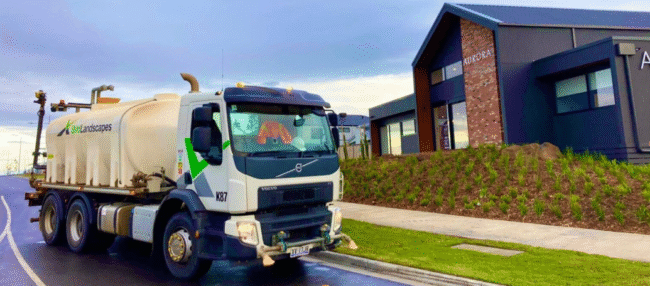
Everyone wants their home to have some greenery, be water wise and a nicer place to live without needing daily care.
There are ways residential developers can incorporate these elements into a new development that do more than just look nice. More and more, it’s about using less water, using fewer resources and performing well with low hands-on care.
Choosing the right plants that work together, having irrigation that’s efficient and thinking through how the spaces will be maintained over time is a necessary part of landscape and residential development. It’s all about building spaces that work hard, with little ongoing care.
Plant first
Low-maintenance green space starts with the plants. Using native plants that suit the local climate and soil is naturally low fuss. Many new developments are using hardy shrubs, grasses and ground covers like Lomandra, Dianella and Westringia that only need a little watering. They are native species that will support local insects and birds, with direct environmental benefits too.
These plants are more drought tolerant, need little fertiliser and don’t need to be pruned. They are great for shared or common green space in high-density housing, where daily care just isn’t feasible.
The design has changed too. Selecting plants with similar water and care requirements makes it easier to maintain over time. Layered planting also helps suppress weeds and retain soil moisture. These changes reduce costs and create healthier green spaces that perform well and last longer.
Groupings of similar plants also make it easier for maintenance crews to work efficiently, without having multiple schedules or products for different parts of the same site. It’s one of the smaller, quieter changes that end up making a noticeable difference in ongoing management.
Water wise design and invisible systems
Water use is another element. For medium and high-density developments, green space has to perform and be cost effective. Drip irrigation is common, watering straight at the root instead of spraying out into the air, where the water will either evaporate or run off.
Many systems feed off weather data or soil moisture sensors, watering only when necessary. In these high-density developments, drip irrigation is now expected in areas that have to be cost effective and environmentally friendly. These systems use less water and can be monitored remotely. That means problems can be identified and resolved early on, before they become significant issues. It’s the type of care that happens out of sight, which is exactly what’s needed when on-site maintenance crews are limited or seasonal.
The benefits extend to longevity too. As gardens mature or change over time, irrigation systems that don’t overwater or put pressure on plants, last longer and need less repair.
Surfaces that support low maintenance goals
The layers below the surface are important too. Instead of rushing straight into the stormwater system, rainwater can soak into the soil, alleviating flooding in surrounding areas, without the need for expensive drainage works. If the material is porous concrete, stabilised gravel or pavers, with lots of gaps, it can help feed local plants and add to a green environment. Materials like these are increasingly used in many residential driveways, paths and smaller courtyards.
It also helps encourage healthy soil and plant growth as air and water can move through the material rather than be trapped under an impermeable surface. For vegetated areas around buildings it also helps keep down heat build up and the heat island effect over time.
For those who maintain these areas, they are easy to clean and manage. These surfaces are less likely to crack under the roots of established trees and allow soil to breathe. And in many cases, they also make the area more accessible for everyone, including people using prams, walking aids or mobility devices.
The maintenance of maintenance
Residential landscape maintenance services are also shifting to a more proactive role, which includes scheduled irrigation checks, early plant stress identification and targeted weed control. They are aiming to keep green spaces looking good and performing well with less chemicals and fewer visits. Perhaps even more importantly, these contractors are being engaged early in the process to help identify potential issues and suggest solutions that avoid problems later on. Forecasted costs are more accurate and solutions can be built into the infrastructure itself, rather than added on later.
A quieter kind of green success
Urban residential developments can have inviting outdoor areas that don’t need daily attention as a result of choosing the right plants, using efficient watering systems and relying on practical surface materials.
It’s not a trendy idea—it’s a thoughtful one. With increasing pressure on space and budgets, these simple, low-fuss solutions are likely to become standard. Not because it’s a trend. But because it’s the smart way to do things.
